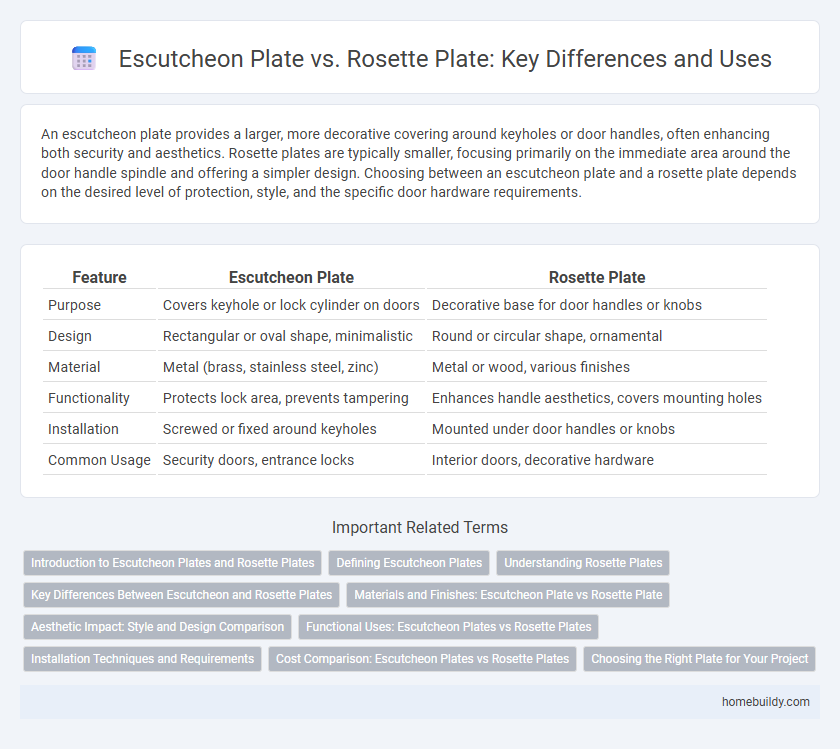An escutcheon plate provides a larger, more decorative covering around keyholes or door handles, often enhancing both security and aesthetics. Rosette plates are typically smaller, focusing primarily on the immediate area around the door handle spindle and offering a simpler design. Choosing between an escutcheon plate and a rosette plate depends on the desired level of protection, style, and the specific door hardware requirements.
Table of Comparison
| Feature | Escutcheon Plate | Rosette Plate |
|---|---|---|
| Purpose | Covers keyhole or lock cylinder on doors | Decorative base for door handles or knobs |
| Design | Rectangular or oval shape, minimalistic | Round or circular shape, ornamental |
| Material | Metal (brass, stainless steel, zinc) | Metal or wood, various finishes |
| Functionality | Protects lock area, prevents tampering | Enhances handle aesthetics, covers mounting holes |
| Installation | Screwed or fixed around keyholes | Mounted under door handles or knobs |
| Common Usage | Security doors, entrance locks | Interior doors, decorative hardware |
Introduction to Escutcheon Plates and Rosette Plates
Escutcheon plates and rosette plates serve as decorative and functional coverings for door hardware and keyholes. Escutcheon plates typically feature a flat or slightly contoured design that protects the lock mechanism while offering a classic aesthetic. Rosette plates, often circular and more ornate, primarily focus on enhancing door handle appearance, providing a smoother transition between the handle and door surface.
Defining Escutcheon Plates
Escutcheon plates are protective or decorative metal coverings designed to surround keyholes or door handles, providing a neat finish and safeguarding the area from damage. Unlike rosette plates, which are typically circular and emphasize ornamental design around door knobs, escutcheon plates often have a more functional role with varied shapes tailored to fit keyholes or lock cylinders. Their durable construction enhances security by shielding lock mechanisms while complementing door hardware aesthetics.
Understanding Rosette Plates
Rosette plates are typically smaller, circular hardware components that cover the area around a door handle or lock cylinder, providing both decorative appeal and protection against wear. Unlike escutcheon plates, which often have a larger, rectangular shape designed to cover keyholes or prevent damage from key insertion, rosette plates focus on enhancing the aesthetic finish around knobs or levers. Understanding the functional and design differences between rosette plates and escutcheon plates helps in selecting the appropriate hardware for door security and style.
Key Differences Between Escutcheon and Rosette Plates
Escutcheon plates provide a protective and decorative covering around keyholes or lock cylinders, emphasizing security and durability, while rosette plates primarily serve as ornamental trim around door handles or knobs. Escutcheon plates often feature reinforced materials to resist tampering, whereas rosette plates focus on aesthetic appeal with various styles and finishes. The key functional difference lies in the escutcheon's role in safeguarding locking mechanisms, contrasting with the rosette's decorative purpose.
Materials and Finishes: Escutcheon Plate vs Rosette Plate
Escutcheon plates are commonly crafted from durable metals such as brass, stainless steel, and aluminum, offering a wide range of finishes including polished, brushed, and antique styles that enhance both protection and aesthetics. Rosette plates, often made from similar metals, typically feature simpler designs with fewer finish options, focusing on minimalistic covers that complement door handles without extensive decorative elements. Both escutcheon and rosette plates provide corrosion resistance and longevity, but escutcheon plates tend to offer more variation in materials and finishes to suit diverse architectural and design needs.
Aesthetic Impact: Style and Design Comparison
Escutcheon plates offer a sleek, minimalist aesthetic that complements modern and contemporary door hardware designs, providing clean lines and subtle detailing. Rosette plates feature more ornate or decorative elements, often with intricate patterns or layered profiles that enhance traditional or classical interior styles. Choosing between escutcheon and rosette plates hinges on the desired visual effect, where escutcheons emphasize understated elegance while rosettes contribute to a richer, more embellished appearance.
Functional Uses: Escutcheon Plates vs Rosette Plates
Escutcheon plates provide a protective barrier around keyholes and locks, preventing damage and tampering while enhancing door aesthetics with a flat or slightly contoured surface. Rosette plates primarily serve as decorative covers surrounding door handles or knobs, concealing the mechanism and screw hardware for a cleaner finish. While escutcheons focus on security and protection, rosettes emphasize ornamental appeal and hardware concealment.
Installation Techniques and Requirements
Escutcheon plates require precise alignment with door hardware and wall surfaces, typically needing secure mounting with screws or adhesive to cover keyholes or lock mechanisms. Rosette plates, often smaller and decorative, focus on centering around door handles or knobs with simpler installation, frequently using concealed screws for a cleaner appearance. Both plates demand compatibility with the door thickness and handle design to ensure functional and aesthetic integration.
Cost Comparison: Escutcheon Plates vs Rosette Plates
Escutcheon plates generally cost more than rosette plates due to their larger size and additional material usage. Rosette plates are typically smaller, resulting in lower manufacturing and material expenses, making them a budget-friendly option for door hardware. Choosing an escutcheon plate offers enhanced durability and aesthetics but comes at a higher price compared to the more economical rosette plate alternatives.
Choosing the Right Plate for Your Project
Escutcheon plates provide enhanced protection and a sleek finish around keyholes or door locks, making them ideal for security-focused installations, while rosette plates emphasize decorative appeal and suit traditional or ornate hardware designs. Choosing the right plate depends on the balance between durability, aesthetic style, and the specific hardware compatibility needed for your project. Prioritize material quality, finish options, and installation requirements to ensure the selected plate meets both functional and visual demands.
Escutcheon plate vs Rosette plate Infographic

 homebuildy.com
homebuildy.com